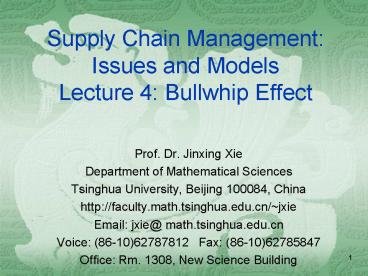Supply Chain Management: Issues and Models Lecture 4: Bullwhip Effect - PowerPoint PPT Presentation
1 / 33
Title:
Supply Chain Management: Issues and Models Lecture 4: Bullwhip Effect
Description:
Supply Chain Management: Issues and Models Lecture 4: Bullwhip Effect Prof. Dr. Jinxing Xie Department of Mathematical Sciences Tsinghua University, Beijing 100084, China – PowerPoint PPT presentation
Number of Views:266
Avg rating:3.0/5.0
Title: Supply Chain Management: Issues and Models Lecture 4: Bullwhip Effect
1
Supply Chain ManagementIssues and
ModelsLecture 4 Bullwhip Effect
- Prof. Dr. Jinxing Xie
- Department of Mathematical Sciences
- Tsinghua University, Beijing 100084, China
- http//faculty.math.tsinghua.edu.cn/jxie
- Email jxie_at_ math.tsinghua.edu.cn
- Voice (86-10)62787812 Fax (86-10)62785847
- Office Rm. 1308, New Science Building
2
????(?)
3
Amplified Demand Distortion (the Bullwhip
Effects)
4
Four sources of the bullwhip effect Demand
signal processing Rationing game Order
batching Price variation
5
Bullwhip Effect An Analytical Model
6
Bullwhip effect
7
Events in each period
8
Variables
9
Demand Process
10
(No Transcript)
11
Results for demand signal processing
12
13
(No Transcript)
14
Optimal order-up-to level
15
Optimal order quantity
16
Amplification of order variance
17
Summary
Bullwhip effect exists even when the leadtime is
zero Other causes of bullwhip effects omitted
here Sharing information is needed?
18
Information sharingValue of information
19
Basic Assumptions
- The demand is assumed to be a simple
autocorrelated AR(1) process -
(2.1) - d gt 0, -1lt?lt1, and ? is i.i.d. normally
distributed with mean zero and variance ?2. - ?ltlt d
20
Leadtimes
21
Retailers ordering decision process
22
Manufacturers decision
23
Retailers Leadtime Demand
24
Retailers Leadtime Demand
25
Retailers Ordering Decision
26
For manufacturer
27
Manufacturers leadtime demand
28
Manufacturers leadtime demand No information
sharing
29
Manufacturers order-up-to level No information
sharing
30
Manufacturers leadtime demand information
sharing
31
Manufacturers order-up-to level information
sharing
32
Benefits of information sharing
- Comparing (3.10) with (3.13), one can quantify
the benefits of information sharing - Inventory level
- Cost evaluation
33
Similar methods can be used to
- Analyze the case when forecasting is used
- Raghunathan S. Information sharing in a supply
chain a note on its value when demand is
non-stationary. Management Science, April 2001,
605-610. - Analyze the value of advance demand information
(the value of time) - Zhao X., Xie J. and Wei J. The Impact of Early
Order Commitment on the Performance of a Simple
Supply Chain. Working paper, 2002, Chinese
University of Hong Kong.































